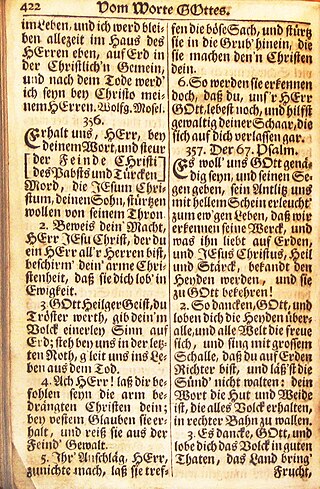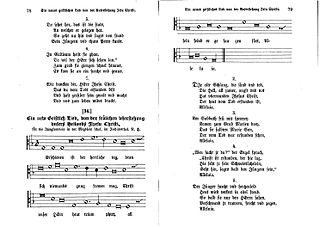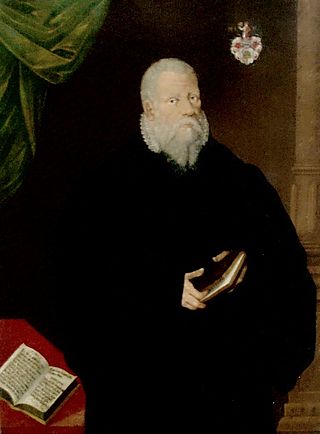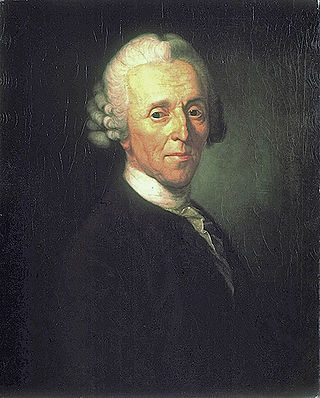
"Nun komm, der Heiden Heiland" is a Lutheran chorale of 1524 with words written by Martin Luther, based on "Veni redemptor gentium" by Ambrose, and a melody, Zahn 1174, based on its plainchant. It was printed in the Erfurt Enchiridion of 1524.

Elisabeth Cruciger, a German writer, was the first female poet and hymnwriter of the Protestant Reformation and a friend of Martin Luther.

Evangelisches Gesangbuch is the current hymnal of German-language congregations in Germany, Alsace and Lorraine, Austria, and Luxembourg, which was introduced from 1993 and 1996, succeeding the Evangelisches Kirchengesangbuch (EKG). Evangelisches Gesangbuch appears in 14 different regional editions, which add regional hymns to the 535 hymns common for all editions.

"Gelobt sei Gott im höchsten Thron" is a hymn for Easter in 20 stanzas in German by Michael Weiße, widely known with a later melody by Melchior Vulpius. Shortened, it is part of current Protestant and Catholic German hymnals.

"Erhalt uns, Herr, bei deinem Wort" is a Lutheran hymn by Martin Luther with additional stanzas by Justus Jonas, first published in 1542. It was used in several musical settings, including the chorale cantata by Johann Sebastian Bach, Erhalt uns, Herr, bei deinem Wort, BWV 126.

"Such, wer da will, ein ander Ziel" is a Lutheran hymn in five stanzas with a text written by Georg Weissel in 1623 to a melody that Johann Stobäus had created in 1613.

"Christe, du Lamm Gottes" is a Lutheran hymn, often referred to as the German Agnus Dei. Martin Luther wrote the words of the hymn as a translation of the Latin Agnus Dei from the liturgy of the mass. The tune, Zahn 58, was taken from an older liturgy. The hymn was first published in 1528 and has been the basis for several musical settings by composers such as Bach, Mendelssohn and Hessenberg. It appears in modern German hymnals, both the Protestant Evangelisches Gesangbuch and the Catholic Gotteslob.

"Die beste Zeit im Jahr ist mein" is a hymn by the Protestant reformer Martin Luther. He wrote it not as a hymn but as part of a longer poem which appeared first in 1538. In the current Protestant German hymnal Evangelisches Gesangbuch, it is EG 319.

"Erschienen ist der herrlich Tag" is a German Easter hymn, with text and tune written by Nikolaus Herman and published in 1561. It has inspired musical settings by composers from the 17th to the 20th century. It appears in several hymnals, including the German Protestant hymnal Evangelisches Gesangbuch. Other hymns, especially Easter hymns, in both German and English, are sung to the same melody.

"Meinen Jesum laß ich nicht" is a German Lutheran hymn, with lyrics by Christian Keimann written in 1658. The theme of the hymn is trust in Jesus, based on memorial sermons for John George I, Elector of Saxony recalling conversations of the elector with his minister on his deathbed.

"Nun lasst uns Gott dem Herren" is a Lutheran hymn of 1575 with words by Ludwig Helmbold. It is a song of thanks, with the incipit: "Nun lasst uns Gott dem Herren Dank sagen und ihn ehren". The melody, Zahn No. 159, was published by Nikolaus Selnecker in 1587. The song appears in modern German hymnals, including in the Protestant Evangelisches Gesangbuch as EG 320.

"Sonne der Gerechtigkeit" is a German Christian hymn with a complex history. The image of a sun of justice or righteousness was created by the prophet Malachi. The text was compiled around 1930 by Otto Riethmüller from older stanzas by different hymnwriters, intended as a wake-up call to the church in a Germany facing the rise of the Nazis. Four of its originally seven stanzas were written in the 18th century, two by Johann Christian Nehring, and two by Christian David. The remaining stanzas were taken from Christian Gottlob Barth, written in the 19th century. An alternative seventh stanza was suggested in 1970, with a strong ecumenical focus. The hymn expresses a call for justice, renewal and unity, within the congregation and church, and among peoples.

Johann Balthasar König was a German Baroque composer, especially of hymn melodies, having published a hymnal with 1,913 melodies. He was the church musician at Frankfurt's main Protestant church, the Katharinenkirche, and the town's Kapellmeister. He was also closely associated with Georg Philipp Telemann.

"Macht hoch die Tür" is a popular German Advent hymn, written in 17th century Ducal Prussia. The lyrics were written by Georg Weissel in 1623 for the inauguration of the Altroßgärter Kirche in Königsberg. The melody that is now associated with the text appeared first in 1704 in the hymnal by Johann Anastasius Freylinghausen.
"Der Morgenstern ist aufgedrungen" is an Advent song and Christmas carol with lyrics by Lutheran minister Daniel Rumpius, published first in 1587. The common melody by Michael Praetorius appeared later in 1609. It was reprinted, slightly revised by Otto Riethmüller in 1932, and is part of the current Protestant hymnal Evangelisches Gesangbuch and other song books.

"Wir pflügen und wir streuen" is a sacred song about thanksgiving for harvest, with text by Matthias Claudius. It was first published in 1783 as Das Bauernlied. It became a hymn, with melodies by Johann André and Johann Abraham Peter Schulz. It appears in the current German Protestant hymnal Evangelisches Gesangbuch as EG 508 with the latter melody, and is used mostly for the German Erntedankfest. The song is also known by its refrain, "Alle gute Gabe". Jane Montgomery Campbell translated it to English in 1861 as "We plough the fields and scatter".

"Mit Ernst, o Menschenkinder" is an Advent hymn by Valentin Thilo. It partly paraphrases the call to penitence by John the Baptist. The text was first published in 1642 in the collection Preußische Festlieder. The different melody that later became popular dates back to 1557.

"Herr, stärke mich, dein Leiden zu bedenken" is a Passion hymn in German, written by Christian Fürchtegott Gellert to the melody of "Herzliebster Jesu", and first published in 1757. It is contained in the German Protestant hymnal Evangelisches Gesangbuch.
Kurt Rommel was a German Protestant pastor of the Evangelische Landeskirche in Württemberg, author of spiritual books, and hymnodist. He wrote text and tune of hymns contained in both Protestant and Catholic hymnals.
"Dir, dir, Jehova, will ich singen" is a Lutheran hymn, with 1695 text by Bartholomäus Crasselius. A melody attributed to Johann Sebastian Bach appeared in Schemellis Gesangbuch. It was translated into English by Catherine Winkworth in 1863 as "Jehovah, let me now adore Thee". The song became part of many German hymnals, such as Evangelisches Gesangbuch and Gotteslob. From the 1930s, the hymn has often been rendered as "Dir, dir, o Höchster, will ich singen".


















